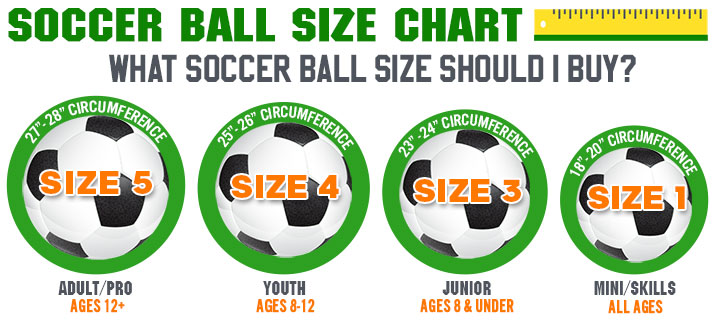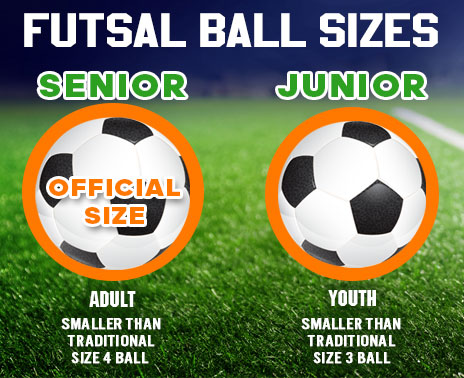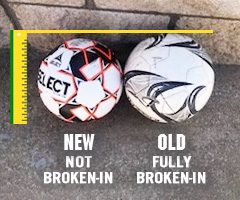
What size soccer ball should I buy?
How to choose the right soccer ball size:
There are a number of different factors that can determine the soccer ball size a player will use. For example, soccer ball sizes vary by age group, by individual league standards, or by the purpose of use (for training, for game play, etc). However, the most commonly used factor in determining soccer ball size is player age group.
The following size chart identifies the recommended age groups by soccer ball size. You'll also find more information on each soccer ball size below.
Size 5 Soccer Balls
Size 5 soccer balls are recommended for players ages 12 and older. Size 5's measure 27-28 inches in circumference (68-70 cm) and weigh approximately 410-450 grams. Size 5 balls are used in adult/professional match play. The highest quality, most expensive size 5 soccer balls are FIFA approved. FIFA stamped soccer balls undergo strict testing for shape, circumference, roundness, weight, size retention, water absorption, loss of pressure and rebound.
Size 4 Soccer Balls
Size 4 soccer balls are recommended for youth players ages 8 to 12. Size 4 balls measure 25-26 inches in circumference (63.5-66 cm) and weigh approximately 350-390 grams. Smaller than a size 5 adult ball, size 4 balls tend to be beneficial in the skill development of young players. The decrease in size allows for better ball control by younger players, whereas a size 5 ball might be too large to develop proper dribbling and passing skills.
Size 3 Soccer Balls
Size 3 soccer balls, also known as junior soccer balls, are recommended for ages 8 and younger. Size 3 balls measure 23-24 inches in circumference (58.5-61 cm) and weigh approximately 300-320 grams. Size 3 soccer balls are the smallest ball size used in competitive play. Size 3's are ideal for the skill development of small players who are just learning the game.
Size 1 Soccer Balls
Size 1 soccer balls, also known as mini soccer balls, measure 18-20 inches in circumference (46-51 cm). While some coaches might use size 1 balls for footwork and ball control training, their most practical/common use is for general entertainment and souvenir collection. The small size of these balls makes them best suited as team logo souvenir soccer balls.
Futsal Balls
Futsal is FIFA’s officially approved small-sided soccer. Compared to traditional soccer game play, Futsal games are played on a smaller field, with less players, and with a smaller ball. There are just 5 players per team in Futsal game play, compared to 11 per side in traditional soccer play. An offical size FIFA approved Futsal ball is slighly smaller than a traditional size 4 ball, with a circumference between 24.61" and 25.0". Official size balls, also referred to as "Senior" Futsal balls, are used by adult players. Youth players use "Junior" size Futsal balls, which are approximately the same size as a traditional size 3 soccer ball. Some manufacturers refer to official/senior size Futsal balls as "Size 4" balls, and the junior size Futsal balls as "Size 3" balls.
Inner Soccer Ball Construction
- The Bladder—The bladder is the very inner portion of the ball that holds the air. The stronger the bladder, the less likely a ball is to leak, which causes a ball to lose its feel and resiliency.
- Butyl bladders are more durable, responsive and better at retaining air. You will typically find that balls with butyl bladders are sold in the middle to high price range.
- Latex bladders, which are soft and more responsive, have a problem with leakage. You will need to refill them at least once a week, something that most players will abhor because it is a hassle.
- The Lining—The lining, the material that lies between the bladder and cover, may be made of polyester, cotton, foam or other cushioning filler. It has several purposes:
- To give the ball a better, more spherical shape. The rounder the ball, the more accurate a player’s kick will be time after time.
- More lining creates a bouncier feel and more responsive touch; two qualities that make a ball better to play with.
- For a longer lifetime, the lining of a ball is increased.
- Typically, pro balls will have four layers or more while practice balls may only have one or two.
Outer Soccer Ball Construction
- The Cover— Synthetic leather covers make up the majority of the soccer ball market, although full grain leather was used in the past. The reason for the switch is that leather absorbs water, and the more water a ball absorbs, the heavier it gets. Balls should remain light and bouncy so that players don’t have to exert more force to propel the ball forward.
- There are two types of synthetic covers and you’ll see that they make all the difference in the cost of a ball.
- For practice, PVC (poly vinyl chloride) is the most durable and are quite common because they are inexpensive.
- Durable PU balls (polyurethane) are the more expensive and are what the better players prefer. These are certainly the best choice for game play balls since they have a nice feel and better responsiveness.
- The Stitching— A ball’s stitching is what holds together the 32 pentagonal and hexagonal panels that make up a ball’s outer surface. The tighter and more securely wound the stitching is, the longer the ball will hold up.
- Glued panes are typically the least expensive and are commonly found on practice balls.
- Machine-stitched balls don’t hold up as well as hand-stitched balls. Nonetheless, hand-stitched balls, due to the time required to construct them, cost more.
- Thermally molded panels are found on some of the newer soccer balls, especially those that are used for professional purposes.
- For the best quality ball, go for one stitched with 5-ply polyester thread, which is the strongest type.
- Kevlar reinforcement also helps improve the durability of the stitching.
Soccer Ball Break-in Period
A soccer ball requires a break-in period to reach its perfect circumference, similar to the break-in time needed for leather baseball gloves or leather shoes. A new, unbroken-in soccer ball is smaller when compared to a fully broken in ball (see example in image below). The reason is that all soccer balls whether they are bonded, hand-sewn or machine-sewn, will stretch after use.
A size 5 soccer ball’s circumference should be between 27-28 inches. However, at first inflation to a proper PSI, a new ball will be slightly smaller in circumference than the 27-28 inches. But, after one practice the ball will reach its perfect circumference.












